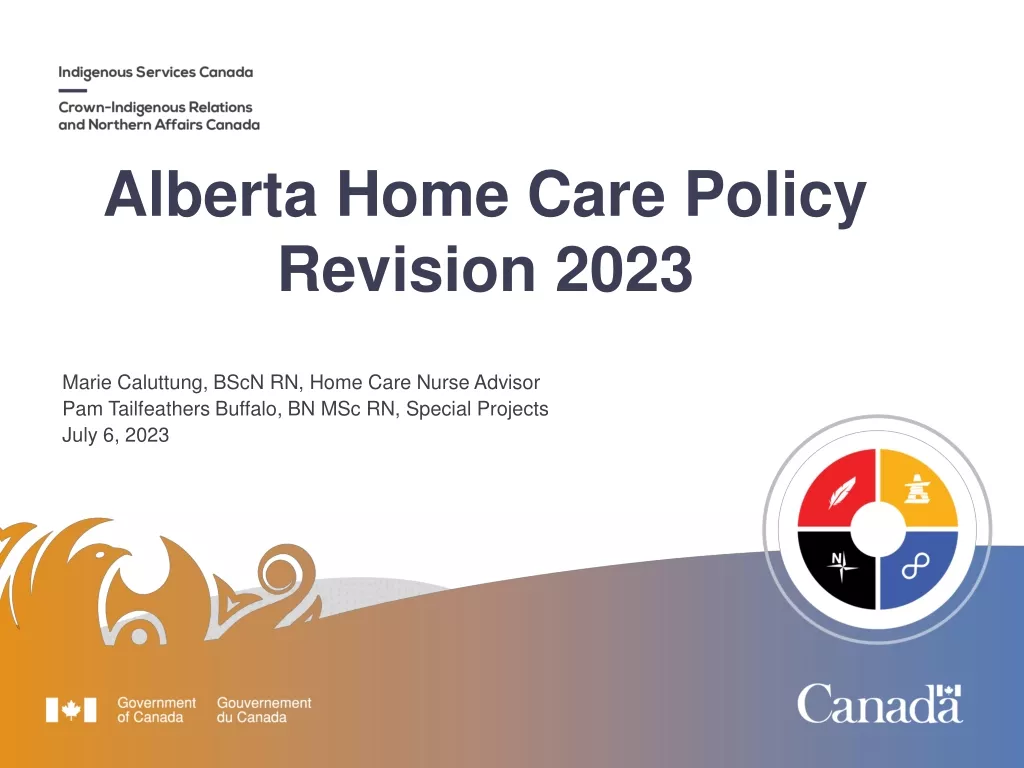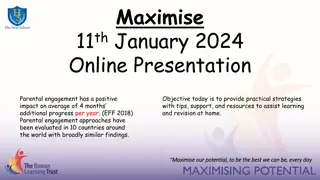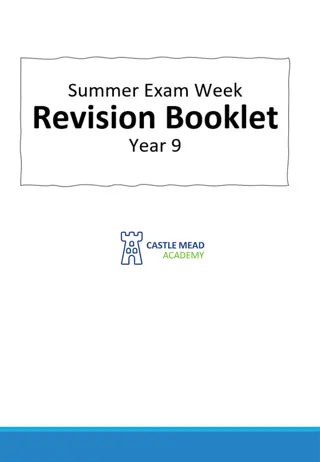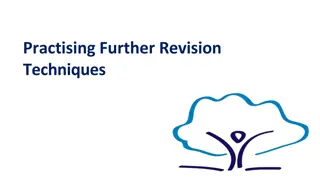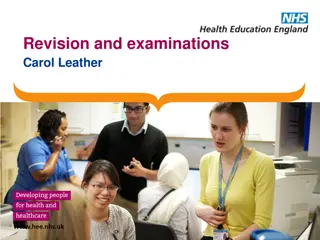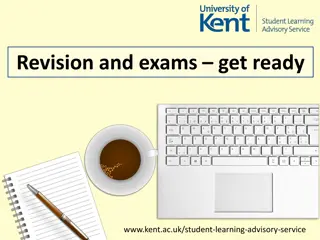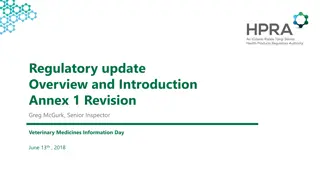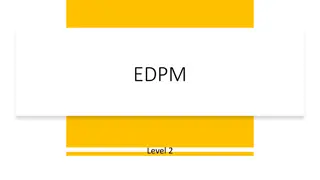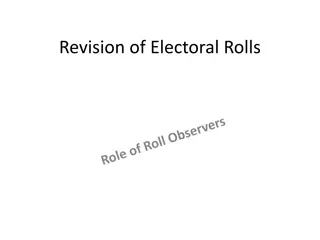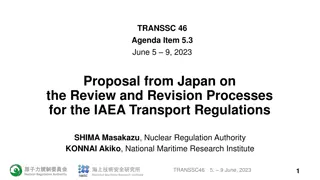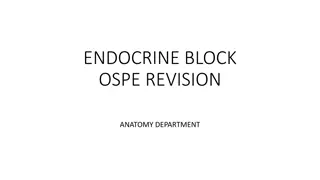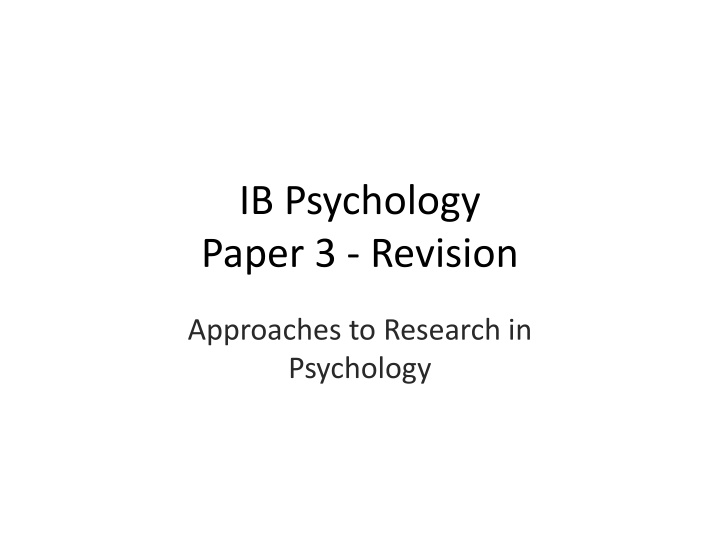
Approaches to Research Methods in IB Psychology Paper 3
Prepare for your IB Psychology Paper 3 with this detailed guide on research methods. Get insights on timing, question formats, and marking criteria. Learn to identify and outline characteristics of research methods, sampling methods, and alternative approaches, helping you tackle each question effectively. Enhance your understanding of quantitative and qualitative research methods, such as experiments, case studies, and more. Ace your exam with strategic reading and planning techniques to optimize your writing time within the one-hour constraint.
Download Presentation

Please find below an Image/Link to download the presentation.
The content on the website is provided AS IS for your information and personal use only. It may not be sold, licensed, or shared on other websites without obtaining consent from the author. If you encounter any issues during the download, it is possible that the publisher has removed the file from their server.
You are allowed to download the files provided on this website for personal or commercial use, subject to the condition that they are used lawfully. All files are the property of their respective owners.
The content on the website is provided AS IS for your information and personal use only. It may not be sold, licensed, or shared on other websites without obtaining consent from the author.
E N D
Presentation Transcript
IB Psychology Paper 3 - Revision Approaches to Research in Psychology
What will the paper look like? A fairly lengthy summary of a piece of either quantitative or qualitative research This is called a scenario All IB exam have 5 minutes reading time before you can start writing You are not allowed to annotate during the reading time. Once the 5 minutes has elapsed, read and annotate the scenario During the second read through, highlight information that helps you to understand the study and specifically to answer the three questions. You will be marked out of 24 marks.
Timing in this exam You can one hour for Paper 3 There are 24 marks available If you set ten minutes aside for reading, annotating, planning, thinking and proofing this leaves 50 minutes This would mean roughly 2 minutes per mark average-high levels students write 40-50 words in 2 minutes, this would suggest quite a lot of writing per mark in most instances; In terms of getting a creditworthy level of depth I would aim for roughly two richly detailed sentences per mark.
Question 1 Three parts, each worth 3 marks; marked using an analytical mark scheme . The three questions are: Identify the research method used and outline two characteristics of the method. (3) Describe the sampling method used in the study. (3) Suggest an alternative or additional research method giving one reason for your choice. (3)
Identify the research method used and outline two characteristics of the method. (3) Take care! The IB recognises specific things as research methods so make sure you select on from the following trusted methods the research method is likely to be explicitly mentioned in the scenario; finding this information is your first job! it may not be mentioned explicitly mentioned meaning you will need to find information which helps you to identify the chosen research method from the scenario.
Suitable Quantitative Research Methods Experiment Laboratory Field Quasi Natural Correlational research
Suitable Qualitative Research Methods Case studies Naturalistic Observations Interviews
Timing in Q1a The commands terms in this question are identify and outline We have allocated roughly 2 minutes per mark in this paper, however identifying the research method literally means writing two or three words We have suggested 40-50 words per mark yet this may be excessive given the command term is outline, while its important not to write too little and miss marks through brevity you also don t want to waste time where the little bit that you saved on Q1a could help you elsewhere.
Interview The guide mentions three types of interview: Unstructured semi-structured focus groups Therefore in part 1 a you should hopefully be able to identify what type of interview has been used, if you do not specify the type of interview you may not get the mark - take care, e.g. write semi-structured interview not interview.
Drop-down menu: Interviews Used to gain an insight into people s thoughts, opinions and feelings from their own point of view. may be followed by surveys (a quantitative method) to collect data from a representative sample so that the findings can be generalized to a larger population. Could, for example, be a useful way to explore a psychological phenomenon in a case study.
Characteristics of Interviews: Semi-structured Interview schedule specifies pre-determined topics or themes to be explored; creating an interview schedule means the researchers should ensure that these topics are discussed and they can be agreed with the interviewee in advance of giving informed consent The interviewer can deviate from the questions in the interview schedule and ask questions in a different order or introduce new questions based on the interviewee s previous response Interview schedule may include both open and closed questions: open questions prompt longer, richer answers from respondent allowing them to elaborate in their own words without being guided in any particular direction by the interviewer closed questions result in brief, precise answers of just a few words. Informal and conversational ; the face-to-face situation and the open- ended questions may resemble a normal conversation and facilitate a rapport between the interviewer and the respondent which may be helpful in getting the respondent to give detailed answers to more sensitive topics.
Characteristics of Interviews: Unstructured The unstructured interview is characterised by flexibility and freedom the interviews schedule specifies topics/themes but is not broken down into individual questions, with specific wordings; questions are constructed ad hoc based on the direction taken by the intervewee. The interviewee guides the nature of the interviewer s questions thus well suited to Pps from diverse backgrounds who may have differing experiences/perspectives Can be more revealing than other types of interview which are guided by the preconceptions of interviewer s who create the schedules; can increase validity
Characteristics of Interviews: Focus groups A focus group is a group interview which is used to study what a specific group of people think or feel about a topic Group size- eight to twelve people. May be difficult for everyone to participate actively if group is too big focus group members often share a common characteristic relevant to the research meaning purposive sampling is ideal here. Sometimes Pps already know each other so might use snowball sampling group processes help people explore and clarify their views in ways that would be difficult to achieve in one-to-one interviews Shared experience often bonds the group allowing for a quick sense of belonging and trust which facilitates disclosure and talking to others sparks idea and brings people into the conversation i.e. Pps talk freely about their experiences as they are supported by like-minded others; the Pps ask questions of each other that the researcher may not have thought of Researcher acts as group facilitator Help monitor the discussion, keep them on the topic if they veer off into a topic that is not relevant to the research; ensure issues raised are responded to They introduce the members to each other and the topic for discussion Ensure topics are filly explored within the time available
Describe the sampling method used in the study. (3) You will be awarded one mark for correctly naming the sampling method Take care: you must choose one from the expected answers: Random Convenience/opportunity sampling Volunteer sampling Purposive sampling Snowballing (a way of obtaining a purposive sample) There are two marks available for describing characteristics of the sampling method. You need 80-100 words of description; this could include two characteristics in depth or more than two is less depth. Be sure to contextualise each point in your answer carefully using detail from the scenario.
Suggest an alternative or additional research method giving one reason for your choice. (3) One mark for stating the alternative/additional method from the accepted options (lab, field, natural or quasi experiment, correlational, interview, naturalistic observation, case study); be sure to contextualise each point carefully using information from the scenario. I would not deviate from the named methods in the guide e.g. don t suggest survey if scenario method was interview unstructured interview if the method was semi-structured Participant observation if the method was non-participant these would not be an alternative METHODS, they would be an alternative sub-types of method and therefore may not gain credit.
Question 1 c The second two marks are for explaining the reason why you have chosen this alternative/additional method To gain the two marks, I would suggest explaining how and why this would improve the study. You need a good working knowledge of the strengths and weaknesses of all named research methods Your rationale might include reference to weaknesses of the method used in the scenario (for this particular study) and then showing how the strengths of your suggested method would help overcome these problems.
Example 1c for a scenario where the method was interviewing The researcher could use a naturalistic observation, by positioning a researcher in the street to observe how people respond to a real homeless person whilst out shopping. This reason for this is that it would improve the credibility of the data in comparison with interviewing, which can be prone to social desirability bias, e.g. people might have wanted to appear compassionate and generous whereas the reality is they might just ignore a homeless person in real life. This method would improve the credibility as participants would not know they were being observed and would behave in a more natural manner, e.g., the researcher could pretend to wait for a bus whilst texting but really they would be recording field notes about how unassuming passers-by behave when they get near to a homeless person.
Question 2 Your paper will include ONE of the following questions, for a total of 6 marks The question will be assessed using an analytical mark scheme. Describe the ethical considerations that were applied in the study and explain if further ethical considerations could be applied. (6) Describe the ethical considerations in reporting the results and explain additional ethical considerations that could be taken into account when applying the findings of the study. (6)
Describe the ethical considerations that were applied in the study and explain if further ethical considerations could be applied. (6) Up to three marks for describing ethical considerations in the study Up to a further three marks for explaining if further considerations could be applied Ethical considerations include: Consent: Fully, partially informed (presumptive, proxy, general prior) Deception must be justified Harm: Protection from undue physical and/or psychological harm/stress Right to withdraw Anonymity and confidentiality Debriefing
Commands terms; Describe and Explain The first three marks are description (150 words); use the characteristics from the table but make sure each point is fully contextualised; no link to scenario no mark. The second three marks are explanation, i.e. how would you implement your ethical consideration (75 words; about three sentences) why would this make the study more ethical what would the strengths be of this modification (75 words; about three sentences) If you don t have enough to say for second three marks by looking at one extra ethical consideration, then try suggesting two modifications that could be made. You should write around 300 words in total for this question; 150 for describe and 150 for explain.
Describe the ethical considerations in reporting the results (3) The second version of Q2 also has two parts and again a good way to structure your answer is to separate them and write for three marks on each. You would need to write around 150 words on the above section of this question (based on 2 mins per mark and 25 words per min) If you could think of three considerations, this would be 50 words or two sentences per point. The focus in this question is on REPORTING; this question is not about costs to participants, it is about the way the study is communicated in the write-up once the work is in the public domain, it may be used by others in order to bring about benefits to society, however, studies also have the possibility of bringing harm unless psychologist safeguard against this in the way they write up the report
Ethical considerations in reporting Aim to write 150 words for this section You could describe one or more considerations in this paragraph. Once a study has been completed the analysis should be shared with the Pps, including any next steps i.e. what direction future research might take based on this study if any interventions for example might be developed from the findings. Much of what you write here will be linked directly to information found in the scenario; if the examiner decides to ask this question, hopefully the scenario will have been written to include suitable hooks for you to find and use
Ethical considerations in reporting could include: When writing up your report for publication, presenting a poster or talking at a conference Anonymity; links to psychological harm especially for vulnerable people and sensitive research topics; can be particularly hard with case studies of unique individuals; At conferences it could be easy to be caught off guard by a question from the audience and accidentally breach confidentiality or say something that could be seen as unethical especially if the topic is socially sensitive care needs to be taken when giving characteristics of the sample (e.g. making the organisation from which they were drawn recognisable) Giving Pps access to the analysis to check for fitness a way of credibility checking in qual. Research to ensure the final report is as meaningful as possible Putting support in place for Pps before the report comes out Possible legal issues linked to reporting, e.g. libel. Need to remember that journal articles are read by non- professionals too as many journals are now open access online
When being asked about your study in an interview with the media Psychologists might be asked to report their findings in the media, and be interviewed about their research they should be mindful when answering an interviewer s questions especially if asked about something a little left-field and outside of their area of expertise/competence Psychologists should ask for the interview questions in advance so that they can well prepare avoiding poorly considered soundbites that could be used to ill effect when quoted in other sources at a later date. BPS provides media training to avoid such issues. Psychologists must be mindful of their elevated social status and subjective credibility conferred by their title (e.g. Dr, Professor); people will believe what they say so they must communicate with due care.
and explain additional ethical considerations that could be taken into account when applying the findings of the study. (3) Psychological findings may have far reaching consequences for society, informing political, educational, health economic policies for example; use the scenario carefully to think about how this study could be applied in the real world Because psychology occupies such as special position in society, i.e. it has so many applications and possible benefits to society, it is crucial that these are carefully thought through before being broadcast to the wider world Lack of planning in this area could lead to people could misconstrue what the study actually shows, making suggestions about applications which are inappropriate given what has actually been shown Think about correlational studies and cause and effect for exmaple.
Further considerations Peer review is an important part of ensuring that a study is in good shape before publication; ensures that the statistical analysis is rigorous and appropriate meaning the study is unlikely to make any false claims based on poor analysis. It is critical that the procedure of the report is detailed so it can be fairly scrutinised as this will help with the process of evaluating limitations which could mean findings should not be applied in certain ways for example. The discussion section should include detailed limitations section and qualitative reports should include a section on personal and epistemological reflexivity Limitations might relate to the extent to which findings are generalisable/transferrable to other contexts; if findings are inappropriately generalised then interventions and campaigns could be developed which will not work for certain groups (waste of taxpayers money, people s time, raising hope and expectations etc) Lack of replications or inability to replicate; application of findings should not be pursed until we are sure of the reliability/robustness of the findings, (hint: think about the replicability crisis in psychology).
Question 3 Your paper will include one of the following 9 markers. Discuss the possibility of generalizing /transferring the findings of the study. (9) Discuss how a researcher could ensure that the results of the study are credible. (9) Discuss how the researcher in the study could avoid bias. (9) As this is an AO3 command term, treat this as a mini ERQ
Mark scheme for Question 3 Your answer needs to be: focused and effective accurate argument that addresses the requirements of the question (meets commend term discuss ) accurate references to research methods with regard to the question, describing strengths and limitations. effective use of the stimulus material.
The Mark Scheme Unlike the other questions on this paper, this question is marked using bands like the ERQs on Papers 1 and 2. The answer does not reach a standard described by the descriptors below. 0 The question is misunderstood and the central issue is not identified correctly, resulting in a mostly irrelevant argument. The response contains mostly inaccurate references to the approaches to research or these are irrelevant to the question. The reference to the stimulus material relies heavily on direct quotations from the text. 1 3 The question is understood, but only partially answered resulting in an argument of limited scope. The response contains mostly accurate references to approaches to research which are linked explicitly to the question. The response makes appropriate but limited use of the stimulus material. 4 6 The question is understood and answered in a focused and effective manner with an accurate argument that addresses the requirements of the question. The response contains accurate references to approaches to research with regard to the question, describing their strengths and limitations. The response makes effective use of the stimulus material. 7 9
Command term: DISCUSS (an ao3 command term) What does the guide say: Offer a considered and balanced review that includes a range of arguments, factors or hypotheses. Opinions or conclusions should be presented clearly and supported by appropriate evidence In this case, evidence means information from the scenario/stimulus
Structure and length 9 marks x 2 minutes x 25 words = 450. this is a lot given the amount of information in the scenario you will probably write considerably less As this is a mini ERQ, break your answer into: introduction, main arguments, supporting evidence, discussion of arguments and conclusion as normal.
Discuss the possibility of generalizing /transferring the findings of the study. (9) If it s a quaN study the term generalisability is relevant If it s a quaL study the term transferability can be used when talking about applying to groups other than those in the study; also the three types of quaL generalisability (theoretical, inferential and representative)is relevant
Planning the marker: Meeting the assessment criteria This will show that you have understood the question Defining what you understand by generalizing/transferring (depending on whether it s a quan/qual study), also pick our what the findings of the study actually were so you are clear about what exactly we are proposing to generalise. State the extent to which you think the findings can be generalised; if quan think: who are the target population? If quan. or qual. think: what sampling technique was used, sample size, participant characteristics. You could also show awareness that transferability is also about whether the findings are robust (i.e. other corroborating evidence) Contextualise: use the scenario and pick out as much relevant information as you can to support your argument Discuss: Evaluate the sample (size, technique, people included and excluded) with regard to strengths and limitations. Conclude: Re-read you answer and see if there is anything you want to add, e.g. an extra bit of contextualisation, a type of generalisability you have forgotten and then write a concluding sentence which summarises your argument saying who these findings can and cannot be generalised. This shows that you are focused and will demonstrate your understanding of relevant factors This will show your effective use of the stimulus/scenario This shows your awareness of strengths and limitations in regard to the approach taken in the scenario
Discuss how a researcher could ensure that the results of the study are credible. (9) Read the question carefully; its not asking whether the findings are credible or not, its asking HOW the researcher can ensure this not so straight forward Defining what you understand by credibility ; this can encompass a wide array of concepts, e.g. internal/external validity and reliability (QUAN), trustworthiness, triangulation (method/data/researcher) (QUAL); Main argument: Ways the researcher can ensure credibility: how do they triangulate: methods (qual/quan), data (test-retest), researchers (inter-rater); credibility is about validity and any form of bias in the study can reduce credibility what could the researcher do differently to overcome biases? Single/double blind design, reflexivity I would also include: Fit, Relevance, Workability, and Modifiability (concepts from my grounded theory ppt) Contextualise: As before, use the scenario and pick out as much relevant information as you can to support your argument Discuss: Evaluate the suggestions you have made in terms of their strengths and limitations Conclude: Re-read you answer and see if there is anything you want to add before writing a concluding sentence which summarises your argument saying how credibility can be ensured in this study.
Discuss how the researcher in the study could avoid bias. (9) Read the question carefully; its not asking whether the findings are biased or not, its asking HOW the researcher can avoid bias not so straight forward Defining what you understand by bias ; i.e. (disproportionate favouring of a certain outcome; in research its anything which might skew the findings in a certain direction); can encompass a wide array of concepts, e.g. participant bias (double blind, demand characteristics (experimental designs), social desirability, evaluation apprehension), researcher bias (single blind) reflexivity Main argument: Ways the researcher can avoid bias: Researcher bias: Inter-rater reliability/researcher triangulation Quan researcher: single blind design, Qual researcher: reflexivity journal and paragraph in the report Case studies; special issues - longitudinal nature = relationship between researcher and participant Interviewer bias: leading questions, training, think about who is doing the interview; Facilitator in a focus group; body language and paralinguistic can confer agreement and disagreement and shape the interview; inter-rater on transcripts Observer bias; need good training , well operationalised observation schedule; inter-rater Bias during qual analysis; relevance (seek Pps views), saturation Focus groups can become biased; minority influence, groupthink, risky shift Participant bias: Double blind design, wording on standardised instructions, one way mirror in an observation, use independent measures with random allocation Contextualise: As before, use the scenario and pick out as much relevant information as you can to support your argument Discuss: Evaluate the suggestions you have made in terms of their strengths and limitations Conclude: Re-read you answer and see if there is anything you want to add before writing a concluding sentence which summarises your argument saying how credibility can be ensured in this study.


